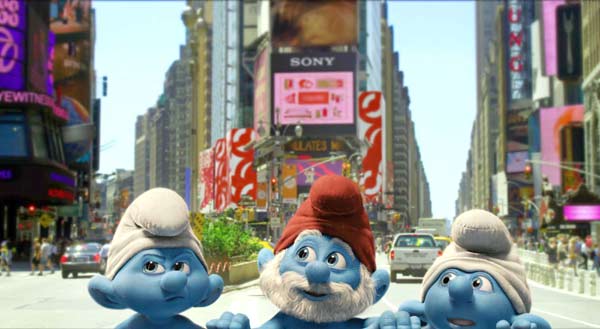“在那山的那边、海的那边有一群蓝精灵……”经历过上世纪八十年代的人们对这首儿歌想必是耳熟能详,蓝精灵快乐生活的场景也都历历在目。2011年的今天,蓝精灵即将卷土重来,以立体动画的形式重上大荧幕。二三十岁的读者们大可趁机怀旧一把,看看陪伴自己成长的小伙伴怎样旧貌换新颜;年轻的读者也不妨体验一下,看看曾经风靡一时的经典如何独具魅力。

蕴翎 选编 曾真 译注
|
Who was the man that dropped out of art school almost as soon as he entered, and whose teacher told him he had no future in cartooning? Who was the mastermind behind the blue empire that helped define a generation of kids in the 1980s? The television show he inspired ran for nearly ten years. Little blue and white creatures were everywhere—and one man from Belgium was responsible for it all. The Smurfs begin with a man named Pierre Culliford, otherwise known as Peyo. Peyo was born in Brussels, Belgium in 1926 to an English father and a Belgian mother. He studied at the Academy of Fine Arts in Brussels but dropped out at 17. He looked in the paper for a job. Two caught his eye: offers for a dental assistant and an illustrator. When he presented himself to the dentist, he was told he was just 15 minutes too late! Peyo began work at the Compagnie Belge d’Animation (CBA), a small Belgian animation studio, where he met a few of his future colleagues, like André Franquin, Morris and Eddy Paape. When the studio folded after the war, the other artists went to work for Dupuis, but Peyo, a few years younger than the others, was not accepted. Peyo followed suit in 1947 and created Johan for La Derniere Heure. This “prototype” Johan strip was about a medieval page boy and ran for a single year. In 1954, Peyo decided to follow Morris to the popular weekly comic Spirou. Johan needed some retooling, so his hair color was changed from blond to black. He was given a “peewee” sidekick. Pirlouit (also called Peewee) was his mischeivous new companion who brought levity and conflict to the comic. The comic was renamed Johan et Pirlouit. It was, in fact, Johan et Pirlouit that gave birth to Peyo’s most popular creation... The Smurfs! 1958 was the year it all began—the year that would change Peyo’s life and legacy forever. In 1958, Peyo created a Johan et Pirlouit story called The Flute with Six Holes. In this story, Johan and Pirlouit meet our little blue buddies, The Smurfs, for the very first time. The Smurfs are three apples tall and live during the medieval era. Peyo stated that the Smurfs were inspired by the trolls of Nordic fairy tales, and that the Smurfs’ blue pallor was selected because it was a color he thought children would like. Dupuis, the company that published Spirou, released a Pirlouit figurine that same year as well. Slowly but surely Peyo’s Smurf figurine army was beginning to assemble. Dupuis wanted to see if The Smurfs could be spun-off from Johan et Pirlouit. They tested The Smurfs comic in special mini-stories to see if the Smurfs would be popular solo. And yes, readers loved The Smurfs! The Smurfs soon eclipsed Johan and Pirlouit in popularity. The Smurfs were popular basically everywhere French-language comics were sold in the 1960s. A Smurf film was the next logical step—a full length Smurf movie, was released in 1976. All the Smurfs needed to do next was to conquer the rest of the world in multiple languages. In 1978, Father Abraham released his famous Smurf Song. The song was an instant hit, and most importantly, it was in English. Finally, the Smurfs were accessible and relevant to English-speaking audiences. Almost the instant after Father Abraham released his song, the UK, Australia and North America began to take notice of the Smurfs. The stage was set for an American invasion—one started in the most peculiar way imaginable: all thanks to a little girl. Melissa Silverman loved the Smurfs. Melissa wanted a Smurfs TV show. Melissa could make it happen. How could this little girl make a Smurfs TV show? Anything is possible when your dad is NBC television executive Fred Silverman! Mr. Silverman contacted Dupuis and the famous Smurf animated series was born. It really was that simple. Peyo could not have imagined how popular his little blue friends would become. The sheer volume of Smurf figurines, dolls, and music sold in the American market was astounding. It was absolutely impossible to be alive in the United States and not see, hear, and experience the Smurfs in the 1980s. They were everywhere: even live Smurf mascots could be found at amusement parks! The Smurfs were icons of the 1980s but things started to slow down in 1989. Once The Smurfs cartoon show ended, Smurf mania began to subside. It was an amazing decade... but the Smurf fun isn’t over yet! The Smurfs didn’t disappear, however. Nothing could stop the success of Peyo’s creation—not even his own death. Peyo died of a heart attack on Christmas Eve, December 24, 1992. Peyo’s heirs have continued to support the Smurfs with collectibles, promotions and publications throughout Europe and the rest of the world. In America, Peyo’s legacy continues with the Columbia Pictures Smurf Movie being released in 2011, part of a planned trilogy. Thanks to the movie, we are finally getting new waves of Smurf collectibles too. It is an amazing time for Smurf collectors because of all the exciting new merchandise (toys, books, clothing and more) currently available for sale. Peyo’s creation is alive and smurfing! Oh...and how did Peyo he get his nickname, you ask? And what about the word “Smurf”? First of all, “Smurf” is not an invented word—it originates squarely with the German surnames “Schlumpff”. The story goes a little something like this... Peyo was at the dinner table and found himself at a loss for a word. He ended up saying, “Pass the... er... er... Schtroumpf”. The word had just the kind of audial quality he was seeking for his newest creation. Thus, the Smurfs were born. As for Peyo, the name is the result of his English cousin’s inability to pronounce his Dutch name, “Pierrot”, properly. |
是谁刚刚踏进艺术学校的大门不久就辍学了?是谁的老师说他在动画界毫无前途可言?又是谁创建了蓝精灵王国,让20世纪80年代的孩子们能够更准确地说明自己那代人的特征呢? 在他的灵感激发下创作的动画片连续播放了将近十年。在那个年代,那群蓝白相间的小精灵无所不在——这一切都得益于一个比利时人的创作。 蓝精灵出自皮埃尔•库利福特之手,他还有个别名叫贝约。贝约1926年生于比利时布鲁塞尔,父亲是英国人,母亲是比利时人。 他曾就读于布鲁塞尔美术学院,却在17岁时辍学。之后,他开始在报纸上找工作,看上了两个职位:牙医助手和插画师。不过,等他见到牙医的时候,却被告知就来晚了那么15分钟! 于是,贝约开始在比利时动画公司(CBA)工作。那是一间小型动画工作室,在那儿,他认识了几个后来的同事,包括安德烈•弗朗坎、莫里斯和艾迪•帕皮。二战后,工作室倒闭,别的插图师都去了迪普伊公司工作,只有年纪稍轻的贝约没被录用。 1947年,贝约也终于加入了迪普伊,还为《最后一刻》创作了约翰这个角色。这个“样板化”的约翰连环画讲的是一个中世纪小听差的故事,连续刊载了一年。1954年,贝约决定追随莫里斯,为当时流行的连环画周刊《斯皮鲁》工作。约翰这个人物形象需要进行一些加工,于是贝约把他的金发改成了黑发,还给他添了个名叫“皮威”的小伙伴。皮鲁伊(也叫皮威)是约翰的新伙伴,喜欢调皮捣蛋,他的出现给这部连环画带来了变化和矛盾冲突。而连环画的名字也因此改成了《约翰和皮威》。 事实上,正是《约翰和皮威》造就了贝约最受欢迎的作品——蓝精灵!蓝精灵诞生于1958年,这一年将永远改变贝约的人生和他将来的遗产。 1958年,贝约给《约翰和皮威》系列写了一个故事,名叫《六孔长笛》。在这个故事里,约翰和皮威第一次结识了我们的那些蓝色小朋友——蓝精灵。蓝精灵家族生活在中世纪,成员身高大致相当于三个苹果叠在一起。贝约曾经说过,蓝精灵的创作灵感来自北欧神话中的巨人们,而为蓝精灵选择浅蓝色调是因为他觉得孩子们会喜欢。那一年,《斯皮鲁》杂志的出版商迪普伊还推出了皮鲁伊的小人偶。不过,贝约的蓝精灵小人偶此刻正迈着稳稳的步子,慢慢招兵买马呢。 之后,迪普伊公司想看看蓝精灵是不是能从《约翰和皮威》中脱离出来、自立门户,于是特别制作了一些蓝精灵的连环画小故事,来测试蓝精灵是否会受欢迎。结果是肯定的,读者都可喜欢蓝精灵了!蓝精灵的受欢迎程度很快便超过了约翰和皮威。 20世纪60年代,蓝精灵在几乎所有出售法语连环画的地方都流行起来。接下来,制作一部蓝精灵电影就成了顺理成章的事。1976年,一部标准长度的蓝精灵电影面世了。对于蓝精灵来说,下一步要做的就是采用多种语言来征服全世界了。 1978年,亚伯拉罕神父推出了他那首赫赫有名的“蓝精灵之歌”。这首歌一面世便大获成功,最重要的是,歌词是用英语写的。至此,蓝精灵终于进入了英语国家观众的视线范围,跟他们建立了联系。亚伯拉罕神父的新歌刚一发布,英国、澳大利亚和北美洲就开始盯上蓝精灵了。一切准备就绪,蓝精灵该进入美国了——第一步特别让人难以想象:这全都得归功于一个小女孩。 梅丽莎•西弗曼很喜欢蓝精灵,她想要一部蓝精灵动画片。可是,梅丽莎没法实现这个愿望。这么个小姑娘怎么拍得出蓝精灵的动画片来呢?不过,如果你爸爸是美国国家广播公司的电视节目总监弗雷德•西弗曼,那就一切皆有可能了!西弗曼先生跟迪普伊公司取得了联系,鼎鼎大名的蓝精灵系列动画片就这样诞生了。事情真的就这么简单。 贝约想不到自己的蓝色小朋友会这么受欢迎。光是在美国市场上卖出的蓝精灵小人偶、洋娃娃和唱片的数量就大得惊人。对于20世纪80年代生活在美国的人来说,要想不看、不听和不接触蓝精灵的故事,是绝对不可能的。他们无处不在,就连在游乐园里都可以看到工作人员扮成的蓝精灵!蓝精灵是20世纪80年代的偶像,但一切从1989年起便放缓了脚步。蓝精灵动画片放完了,对于蓝精灵的狂热便开始降温。那是一个令人惊叹的年代……不过,蓝精灵所能带来的乐趣却并没有就此结束! 但是蓝精灵没有消失;没有什么能够阻止贝约的作品继续蓬勃发展——连他的过世也不例外。1992年12月24日,圣诞前夜,贝约因心脏病突发而辞世。此后,他的继承人继续在欧洲和世界各地维护蓝精灵这一形象,进行宣传、发行纪念品和出版物。在美国,贝约的遗作还在延续:2011年,哥伦比亚电影公司即将推出蓝精灵电影,并计划将其拍成三部曲。这部电影的出现也让我们终于可以买到新一批的蓝精灵纪念品了。对于喜欢收集蓝精灵纪念品的人来说,这可是一个难得的好机会,不少令人兴奋的新玩意儿(玩具、图书、服装等)都有得卖。贝约的作品仍然生机勃勃,活力四射! 哦……对了,你问贝约这个昵称是怎么来的?还有,蓝精灵的英文名“Smurf”又是怎么来的?首先,Smurf这个词不是生造出来的——它是正儿八经地从德语名字“Schlumpff”演化而来的。这其中的故事大致是这样的:有一天吃晚饭的时候,贝约发现自己忘了有个词该怎么说,于是只好说:“请把那个……呃……呃……Schtroumpf递给我一下。”当时,他正在替自己最新创作的形象起名字,而这个词听起来感觉刚刚好,于是蓝精灵就此得名了。至于贝约这个昵称嘛,是因为他那个英国的姑表亲念不好他的荷兰语名字“Pierrot”。 (来源:英语学习杂志) |